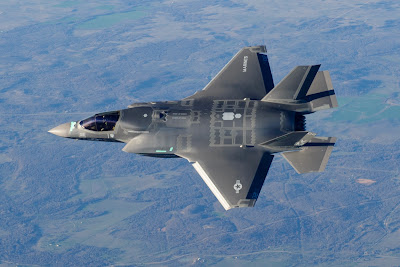Experimental aircraft that actually fly
Some of these craft don’t look as if they would be capable of flight - in fact, they look like they’d not so much fly as plummet. However, these just go to show that if you throw anything hard enough, flight is unavoidable.
Here’s a brief but hopefully fascinating look at some of the more unusual - and successful - experiments with aircraft and flight. Some experimental craft are produced as a scaled-down prototype, which may be flown by remote. Aircraft here are therefore specified as ‘full-scale’, ‘sub-scale’, ‘piloted by remote’ and ‘demonstrator’.
 |
| The autonomous future, where people are no longer necessary. |
 |
| Flugelrad 1 (via) |
Vought V-173, the "Flying Pancake" an American experimental fighter aircraft for the United States Navy (1942).

Lockheed XFV, "The Salmon" an experimental tail sitter prototype escort fighter aircraft (1953).
De Lackner HZ-1 Aerocycle flying platform, designed to carry one soldier to reconnaissance missions (1954).
Snecma Flying Coleoptere (C-450), a French experimental, annular wing airplane, pulsed turbo-reactor, VTOL (Vertical Take Off & Landing) capable (1958).
 |
| Snecma Flying Coleoptere (C-450), |
 |
| Snecma Flying Coleoptere (C-450), |
Dornier Do 31, a West German experimental VTOL tactical support transport aircraft (1967).
 |
| Dornier Do 31 |
Avro Canada VZ-9 Avrocar, a VTOL disk-shaped aircraft developed as part of a secret U.S. military project (1959)
HL-10, one of five aircraft built in the Lifting Body Research Program of NASA (1966 - 1970).
 |
| NASA HL-10 |
Alexander Lippisch's Aerodyne, a wingless experimental aircraft. The propulsion was generated by two co-axial shrouded propellers (1968).
Hyper III, a full scale lifting body remotely piloted vehicle, built at the NASA Flight Research Center (1969).
Bartini Beriev VVA-14, a Soviet vertical take-off amphibious aircraft (1970s)
Ames-Dryden (AD)-1 Oblique Wing, a research aircraft designed to investigate the concept of a pivoting wing (1979 - 1982).
Blohm & Voss BV 141, a World War II German tactical reconnaissance aircraft, notable for its uncommon structural asymmetry.
B377PG - NASA's Super GuppyTurbine cargo plane, first flew in its outsized form in 1980. Similar to the Airbus A300-600ST “Beluga” which was assigned the name “Super Transporter” but officially changed once the nickname has caught on.
X-36 Tailless Fighter Agility Research Aircraft, a subscale prototype jet built by McDonnell Douglas for NASA (1996 - 1997).
Beriev Be-200 Seaplane, a Russian multipurpose amphibious aircraft (1998).
X-29 forward swept wing jet plane, flown by the NASA Dryden Flight Research Center, as a technology demonstrator (1984 - 1992).
Proteus, a tandem-wing, twin-engine research aircraft, built by Scaled Composites (1998).
Stipa-Caproni, an experimental Italian aircraft with a barrel-shaped fuselage (1932).
North American XF-82. Stitch together two P-51 Mustangs, and you get this long-range escort fighter (1946).
 |
| North American XF-82 |
Douglas XB-42 Mixmaster, an experimental bomber aircraft, designed to have a very high top speed (1944).
Libellula, a tandem-winged and twin-engined British experimental plane which gives the pilot an excellent view for landing on aircraft carriers (1945).
Northrop XB-35(1943) an experimental flying wing heavy bomber developed for the United States Army Air Forces during and shortly after World War II.
Martin XB-51, an American "tri-jet" ground attack aircraft with unusual engine configuration (1949).
McDonnell XF-85 Goblin, an American prototype jet fighter, intended to be deployed from the bomb bay of the Convair B-36 (1948). Similar in style was the Northrop XP-56 Black Bullet from the same era.
Douglas X-3 Stiletto, built to investigate the design features necessary for an aircraft to sustain supersonic speeds (1953 - 1956)
Stipa-Caproni CA-60 Noviplano(1932) A nine-wing experimental aircraft prototype for trans-Atlantic voyages for up to 100 passengers. Flew only once and attained a height of 18m (60ft) before crashing.
NASA Experimental Aircraft A comparison of the sizes of a few of the still-functional NASA experimental prototypes. (clockwise from left) the X-31, F-15S/MTD, SR-71, F-106, F-16XL, X-38, Radio Controlled Mothership, and X-36.
 |
| NASA Experimental Aircraft |
Lockheed Martin P-791 is an experimental aerostatic/aerodynamic hybrid airship, originally pitching for the US Army’s LEMV program and later as a lifter in commerce, called the Sky Tug. The first flight of the P-791 took place in 2006
 |
| Lockheed Martin P-791 |
|
|
Airlander 10 is the world's largest aircraft, at a length of 302 feet (92m) and flew twice in 2016, the second outing ending in a nosedive stance in what has been called 'The World's Slowest Accident'. Judge for yourself, the video is => here.
 |
| Airlander 10 - World's Largest Aircraft in 2016 |
Saab 210 A demonstrator aircraft nicknamed ‘LillDraken’ (Little Dragon) - a scaled down testbed for the double-delta design (1952)
 |
| SAAB 210 Double Delta Test |
Unmanned Aerial Vehicle (UAV) USAF drone with tactical surveillance and armaments.
 |
| Unmanned Aerial Vehicle |
Caspian Sea Monster The Ekranoplans have an interesting and detailed history. These amphibious vehicles made use of the ‘ground effect’ air cushion buffer to become (slightly) airborne, making this a very efficient means of transport, albeit limited their use to flat terrain only, such as large bodies of water. This model was developed by Rostislav Alexeyev design bureau (1966)
 | | The 'Caspian Sea Monster" Wing-in-ground-effect Ekranoplan |
|
|
VTOL aircraft
Besides those mentioned above, and helicopters, this lot can also hover...



































































